African black sugar ant (Lepisiota incisa) is a small exotic pest ant.
The ant could become a serious environmental threat and a major nuisance if it became established. It does not sting people or pets.
Detection in Australia
African black sugar ant was first detected in Western Australia (WA) in January 2020. It’s unknown how or when the ant entered Australia.
The detection was made at a commercial premises by WA Department of Primary Industries and Regional Development (WA DPIRD). As a result of further surveillance by DPIRD, a total of 16 clusters of infested premises have now been identified.
The ant has been found in 12 Perth suburbs (Fremantle, Maddington, Welshpool, Wattleup, Forrestfield, Hazelmere, Maida Vale, Jandakot, Balcatta, Kenwick, Narrogin, Landsdale and Bibra Lake), and one regional town (Narrogin, WA).
Response program
This ant is a nationally significant pest and is managed under the National Environmental Biosecurity Response Agreement (NEBRA). WA DPIRD leads the response. The costs of the response are shared between the Australian, state and territory governments. The WA Government contributes additional resources and funding to the eradication program.
A response plan is in place that aims to eradicate African black sugar ant from WA. Treatment is scheduled to be completed by December 2025. Post treatment surveillance, to verify the effectiveness of treatment, is expected to be completed by December 2027. The response plan includes:
- surveillance activities
- chemical treatment of infested sites.
- monitoring after treatment for at least 2 years to verify the effectiveness of treatment.
- legal controls to restrict movement of material that could spread African black sugar ant and to facilitate treatment, where necessary.
- community and business engagement activities to promote cooperation with the program and encourage reporting of suspect ants.
See more
WA African black sugar ant emergency response
How we coordinate a response to an outbreak
National Invasive Ant Biosecurity Plan 2018 - 2028
Your obligations
You can help contain this ant by reporting any suspect sightings.
Avoid accidently moving African black sugar ants. Take care not to move any ants on goods, vehicles, clothes, plant material or soil.
Report sightings
Report suspected sightings of exotic ants, even if you’re not sure.
If you live in Western Australia use the MyPestGuide Reporter app or the MyPestGuide Reporter website. You can also contact the Pest and Disease Information Service on (08) 9368 3080 or padis@dpird.wa.gov.au.
You can call the Exotic Plant Pest Hotline on 1800 084 881 from anywhere in Australia.
For signs of exotic pests and diseases in imported goods, sea containers or parcels, call See. Secure. Report. on 1800 798 636 or use the online form.
Follow the rules
Keep exotic dangerous pests and diseases out of Australia. Never ignore our strict biosecurity rules.
Imports may need to be treated and certified. Before you import, check the Biosecurity Import Conditions (BICON) system.
Movement restrictions
Movement restrictions may be in place at infested sites. Restrictions ensure the ant is not moved out of the area or interstate.
Check with WA DPIRD for the latest information on movement restrictions.
About the pest
African black sugar ant is native to Africa. It is one of several invasive exotic ant species that form super colonies, meaning it has interconnected nests with many queens. A single colony can spread for hundreds of square kilometres. African black sugar ant can establish in a wide variety of habitats. It can thrive in urban areas and undisturbed bush areas, becoming super abundant. The ant displays aggressive behaviour towards other ant species and outcompetes native ants.
The ant can harvest plastic and may damage electrical equipment and infrastructure. Large colonies can disrupt social and business activity. It is not known to be a horticultural pest.
What to look for
The African black sugar ant has a shortened head and midsection. It’s a shiny black colour with thick blackish bristles. The upper surface of its lower midsection has a deep notch on both ends. Its hairless legs are mostly yellow.
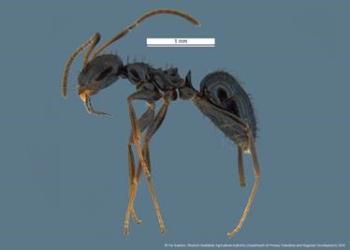
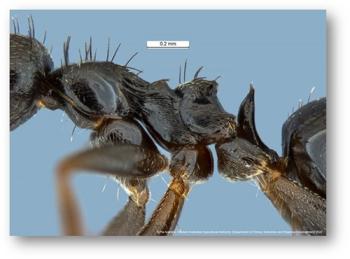
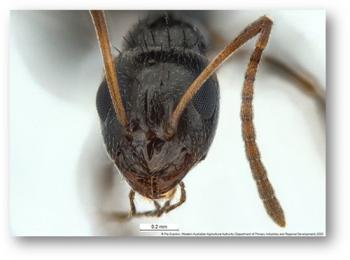
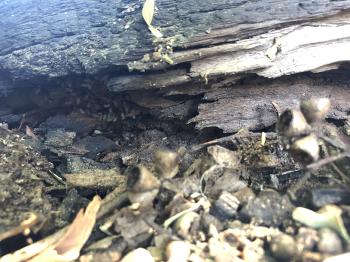
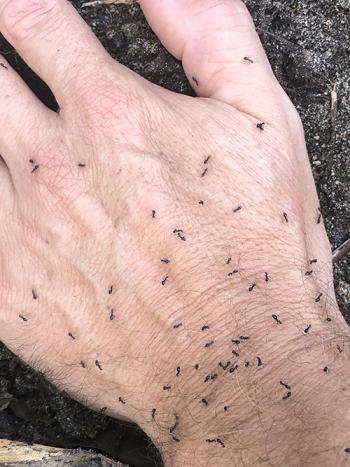
How it spreads
The ant can spread by the movement of goods, vehicles and on clothes. Shipping containers, soil, mulch, fertiliser and plant material can also spread the ant.
The further the ant spreads, the more difficult it is to eradicate.
Resources
See more about the response program or African black sugar ant: